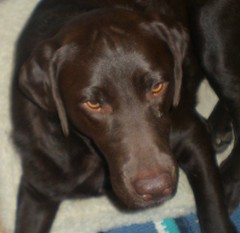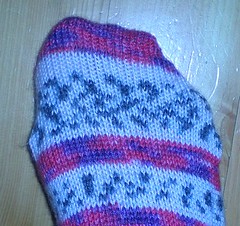 By Amelia
By AmeliaDog ears, belong on dogs. Not socks. But, your standard sock machine sock toe -- a short row toe, kitchenered across the top, usually has dog ears.
Why? I think because you end up with an extra row, the kitchenered row, after you've already knit as many rows on the top of the toe as were on the bottom. That pouches out the corner stitches and wa-la, dog ears. Sticky-outie-bits. Not perfect.
You tell me -- which looks better? the ears on the dog above (woof, he says, cookie?) or the ears on the sock below? (sigh). I agree. Mo wins, hands down.
 My friend Gay taught me a terrific way to cure the dog-eared-ness of the toe that helps out with the Kitchenering as well.
My friend Gay taught me a terrific way to cure the dog-eared-ness of the toe that helps out with the Kitchenering as well.When you are ready to start your toe, with the yarn carrier over the back in the out-of-work stitches, prepare for the toe by moving the stitch from the last needle down on each side, to the needle next to it. Remove the now empty needles.
 Then, put down the two needles out of work on each side, and also move the stitches from the needle by the gap, to the next needle. Remove the now empty needles and re-lift the other needles back out of work. The picture here shows what it looks like when you are done -- there's a gap of two needles at the hash mark, and the stitches that were on them, have been moved to their neighbors. The needles for the top of the foot are out of work while you knit the toe.
Then, put down the two needles out of work on each side, and also move the stitches from the needle by the gap, to the next needle. Remove the now empty needles and re-lift the other needles back out of work. The picture here shows what it looks like when you are done -- there's a gap of two needles at the hash mark, and the stitches that were on them, have been moved to their neighbors. The needles for the top of the foot are out of work while you knit the toe.You have a gap on each side of 2 empty slots. That's quite all right!
Knit your short row toe as you normally would, back and forth, lifting the first needle each time until you get to the hash marks (or wherever you like to stop - on my 72, I stop one before the hash marked slot), then lowering the first needle each time (letting the yarn wrap the latch as I described in my recent heel post).
When you are ready to start your last trip to the right, lower all of the out of work needles. Knit just until the gap, then take your sock yarn out of play and put your waste yarn in play, so the waste yarn starts to knit after the gap. Remember to save enough length of sock yarn to kitchener the toe!
With the waste yarn, knit 10-15 rounds or however many you like to separate/finish a sock.
If you are separating the sock, after a few rows you can add back in the missing needles. Because they are neighbors, I add one in each gap, knit a row, then add the other in the gap. Otherwise the yarn will knit both needles at the same time, not one at a time.
When the sock comes off the machine, it's ready to kitchener. Because you doubled-up the stitches on the top of the foot as well, the waste yarn shows you the two you need to kitchener as one to match up to the stitches on the short row toe. Perfect! Just the right number of rows, no pouching-out dog ear corners. Put 'em on and have happy feet. Let the dog do the barking, not your feet!
Oh, and just a mention -- with this toe, you have two fewer Kitchener stitches to do, to close the toe. Who wouldn't want to do two fewer Kitchener stitches? It's worth the time to move the stitches over and take the needles out.
~~
Yes, I still have to re-knit those dog-ear toed socks. They were the first in my return to the sock machine. I did them on my 80 slot cylinder, and with the lack of elasticity in the yarn, they're also a bit too wide for my leg (they sag, okay?) so I'm going to redo them on my still-on-its-way-here 72, or maybe try out the 64 that's coming in the same box, grin. I guess there is something to having different cylinder sizes, after all! And yes, they will get reknit -- that's yarn I dyed myself!
Oh, and why am I getting both a 72 and a 64? Because both are regulation stitch counts for Socks for Soldiers. I'm not a Socks for Soldiers cranker, but I expect I may contribute at least a one-time sock leg marathon (the heel and foot have to be hand-knit, to a pattern). I'm told that 64 stitches are regulation for the female sizes, 72 stitches for the male.
~~
posted 6 February 2009 at http://askthebellwether.blogspot.com/
